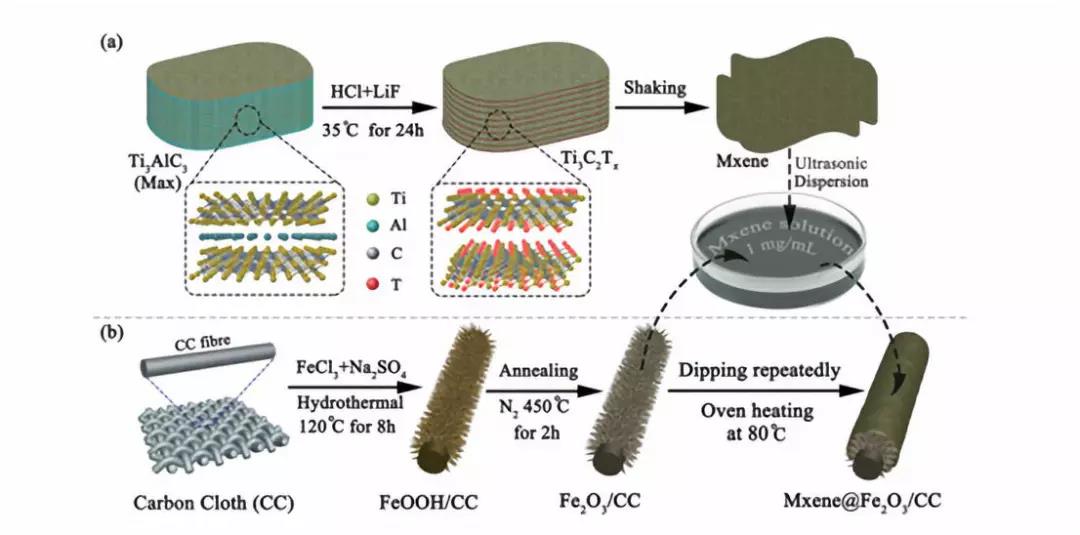Less layer MXene@Fe2O3 for flexible supercapacitors
QQ Academic Group: 1092348845
Detailed

[Background introduction]
Flexible solid supercapacitors (FSSCs) have attracted widespread attention as energy storage devices in the field of modern wearable electronics, including flexible electrodes, solid gel electrolytes, membranes, and flexible packaging materials similar to conventional supercapacitors. Among the above components, the flexible electrode is the most critical part of the flexible supercapacitor, especially when assembling an asymmetric supercapacitor containing two different kinds (negative and positive), the flexible electrode is the most critical factor, and it requires good Electrical conductivity, high capacitance performance, good cycleability and flexibility. However, compared to the rapid advancement of cathode materials, there is still a lack of an ideal anode material to drive the energy density limitations of asymmetric supercapacitors. Therefore, there is a need for a new type of high capacitance, high conductivity anode material.
[Introduction]
Recently, Professor Gui-Gen Wang of Harbin Institute of Technology reported that a flexible anode material with MXene and Fe2O3/CC coupling was prepared by a simple impregnation method, which has good conductivity, high area capacitance and good flexibility. The Fe2O3/CC fiber was completely encapsulated by MXene by repeatedly immersing the Fe2O3 nanorod array on the carbon cloth into the MXene nanosheet solution. The area capacitance of the MXene@Fe2O3/CC electrode is contributed by MXene and Fe2O3 nanorods, up to 725 mFcm−2 at a current density of 1 mAcm−2. For the small layer MXene, it not only provides a capacitor for the flexible electrode, but also provides a fast and efficient ion/electron transmission path for Fe2O3, which effectively improves the electronic conductivity. In addition, the asymmetric supercapacitor device composed of MXene@Fe2O3 and MnO2 exhibits a high energy density of 1.61 mWhcm−3 and good stability at a power density of 22.55 mWcm−3. This work provides a simple and effective strategy for carbon fiber-loaded active materials and for the construction of layered coated structure electrodes for high performance flexible asymmetric supercapacitor applications. The results are published online in the Journal of Materials Chemisty A: Few-layered Ti3C2Tx MXenes coupled with Fe2O3 nanorod arrays grown oncarbon cloth as anodes for flexible asymmetric supercapacitors
[Graphic introduction]

Figure 1 Schematic diagram of the synthesis of Ti3C2Tx MXene (a) and MXene@Fe2O3/CC (b)

Figure 2 (a) XRD patterns of Max (Ti3AlC2), bulk Ti3C2TxMXene, and exfoliated Ti3C2Tx MXene, the inset shows a magnified view from 5 to 12 degrees. (b) Ti 2p high-resolution XPS map of Ti3C2Tx MXene (c) AFM image of MXene@CC (d) TEM images (d1 and d2) of different magnifications, HRTEM images (d3), and SAED of MXene nanosheets ( D4)

Figure 3 (a) SEM image of Fe2O3/CC (b) TEM image of Fe2O3 nanostructure (b1); HRTEM image of Fe2O3 grass (b2 and b3) and corresponding diffraction image (b4); Fe and O of selected region EDS element map (b5 and b6) (c) Fe 2O3/CC Fe 2p high resolution XPS map (d) CC, Fe2O3/CC, and MXene@Fe2O3/CC XRD image (e) CC, Fe2O3/CC , and MXene@Fe2O3/CC Raman spectrum, the internal graph shows the amplified spectrum from 200 to 700 cm-1

Figure 4 SEM images of MXene@Fe2O3/CC (a and b) at different magnifications and corresponding cross-sectional structures (c) (d) MXene@Fe2O3/CC elemental maps of Fe, Ti, O and C and EDS Energy spectrum

Figure 5 (a) CV curves of Fe2O3/CC, MXene/CC and MXene@Fe2O3/CC electrodes with a scan rate of 30 mV s-1 (b) CV curves of MXene@Fe2O3/CC electrodes at different scan rates (c) GCD curve of MXene@Fe2O3/CC electrode at different current densities (d) Calculate the area capacitance of MXene@Fe2O3/CC according to the GCD curve of different electrodes (e) MXene@Fe2O3/CC electrode with different MXene content Nyquist diagram and amplified high frequency internal map (f) Schematic diagram of MXene@Fe2O3/CC coated heterostructure for fast charge transport/storage

Figure 6 (a) XRD images of CC, PCC and MnO2/PCC (b) Mn 2p high resolution XPS pattern of MnO2 /PCC (c) SEM image of MnO2/PCC (d) CC, PCC and MnO2/CC, MnO2 CV curve of /PCC electrode (e) CV curve of MnO2/PCC electrode at different scanning rates (f) GCD curve of MnO2/PCC at different current densities

Figure 7 (a) CV curves for different potential windows at 50 mVs-1 (b) CV curves for different scan rates for two-electrode systems (c) GCD curves for different current densities for two-electrode systems (d) based on current density The lower GCD curve calculates the area capacitance under the two-electrode system (e) the optimal MnO2//MXene@Fe2O3ASCs and the energy comparison chart (volume energy density and average power density) of the ASC device reported in the recent literature (f) MnO2 //Circuit performance of MXene@Fe2O3 devices
[Summary of this article]
For the first time, a layered carbon fiber electrode combining MXene and Fe2O3/CC was prepared by simple impregnation method as a negative electrode material for flexible ASC devices. The constructed MXene layer not only provides capacitance for the flexible electrode, but also provides an electron channel for Fe2O3, shortening the ion/electron transmission path. In addition, the hollow structure formed between MXene and Fe2O3 has a larger surface area, providing an additional Li+ storage location for the electrodes. These factors enable the MXene@Fe2O3/CC flexible electrode to provide high charge storage performance and high area capacitance, reaching 725 mF cm-2 at a current density of 1.0 mA cm-2. In addition, the MnO2//MXene@Fe2O3 asymmetric device thus assembled exhibits a 1.8V high voltage window and high area capacitance at 143.4 mFcm-2 at a current density of 1 mAcm-2 at power densities of 22.55 and 459.46 mW cm-3. The energy density is 1.61 and 0.74 mWhcm-3. This work provides an efficient and simple strategy for building high-performance flexible electrodes, overcomes the main defects of low energy density of supercapacitors, and brings broad development prospects for high-performance energy storage systems.
Literature link:
DOI: 10.1039/c9ta08144e
- Previous: High performance MQW p
- Next: 1


 About us
About us
